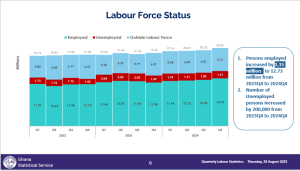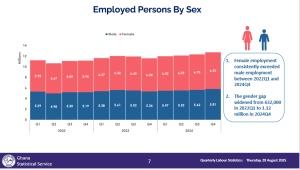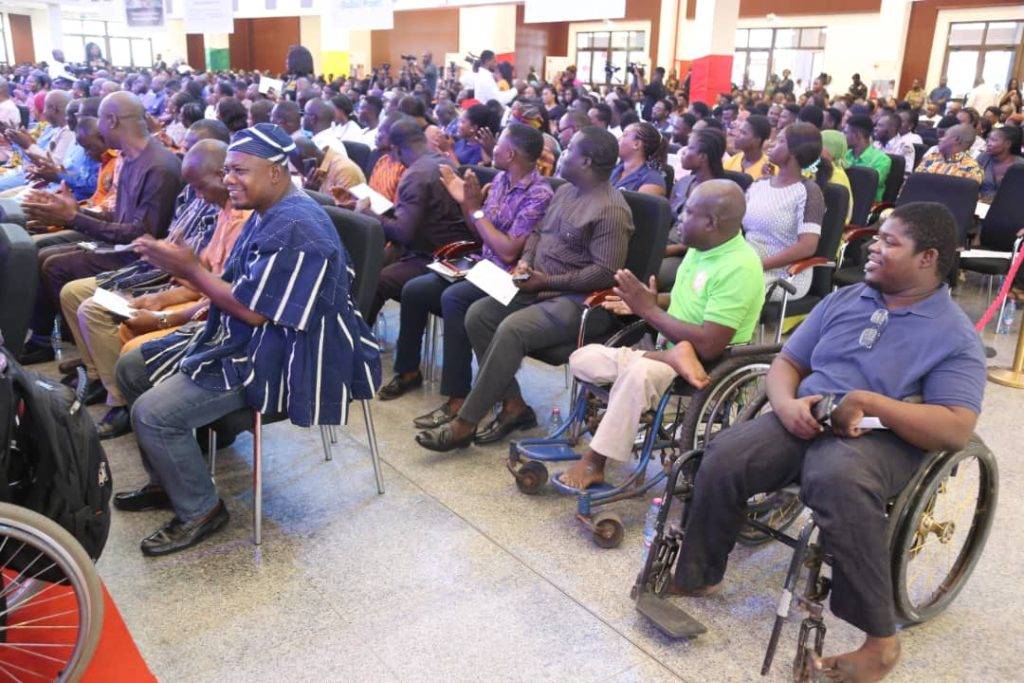
By Juliet ETEFE ([email protected])
The country’s labour market has recorded modest improvements in 2024, with about 409,000 more people employed in the fourth quarter according to latest Quarterly Labour Statistics (July Edition) from the Ghana Statistical Service (GSS).
The increase in employment helped push the national unemployment rate down to 13.1 percent in Q4 2024 from a peak of 14.9 percent in early 2023. The growth in employment has been more urban-driven as urban employment grew by 14.9 percent over the last 3 years compared to a 11.8 percent in rural areas.
The report, based on the Annual Household Income and Expenditure Survey (AHIES), shows that the labour force averaged 14 million persons aged 15 years and older in 2024 with more than 85 percent employed each quarter.
Yet despite the job gains, GSS warns that youth unemployment and long-term joblessness remain entrenched challenges.

Youth hardest hit
The data show that in 2024 the unemployment rate averaged 32 percent for persons aged 15–24 and 22.5 percent for those aged 15–35. Overall, seven in ten unemployed persons were youth – underscoring the struggle of young people to transition from school to work.
In Q4 2024 unemployment among those aged 20–24 years reached 36.7 percent, the highest across age groups.
The share of young people Not in Employment, Education or Training (NEET) also increased, reaching 25.8 percent for the 15–24 group and 22.4 percent for those aged 15–35.
“These findings reinforce the need for targetted interventions that address the structural challenges which continue to lock young people out of the labour market,” the data noted.
Long-term unemployment entrenched
Between 2022 Q1 and 2024 Q4, more than 355,000 people remained unemployed for at least 12 months – with four in ten of the jobless for Q4 2024 falling into this category.
Urban centres accounted for 86 percent of individuals unemployed for three years straight. Males made up the majority of this group, although females continue to experience higher overall unemployment rates.

Gender and locality disparities
Female employment consistently exceeded male employment over the past three years, widening the gender gap in employment from 632,000 in Q1 2022 to 1.12 million in Q4 2024. However, women also faced higher unemployment rates than men.
The gender gap in unemployment narrowed from 7.4 percentage points in Q1 2023 to 3.9 points in Q4 2024, mainly due to a decline of female unemployment.
Urban areas continued to account for a greater share of both employment and unemployment. In 2024, the unemployment rate averaged 15.9 percent in urban areas compared to 10.4 percent in rural areas. While urban unemployment fell between Q2 and Q4, rural unemployment edged upward.
Regional variations
Regional disparities also persisted as Greater Accra and Ashanti Regions consistently reported unemployment rates above the national average despite contributing significantly to employment. In contrast, Eastern, Ahafo, Bono East, Oti and Upper West Regions recorded rates below the national average.
Some regions diverged from the national trend of falling unemployment. Bono, Northern, Upper West and Eastern all experienced increases across 2024. The Northern Region, for instance, saw its unemployment rate rise from 9.5 percent in Q1 2024 to 11.8 percent in Q4 2024.
Informality and underutilisation
Beyond unemployment, the labour market continues to be marked by high levels of informality. Over half of employed women were self-employed without employees, while men were more likely to work in wage employment.
Labour underutilisation – which includes unemployment, underemployment and untapped labour potential – declined from 27.4 percent in Q4 2023 to 19.3 percent in Q4 2024. But rural regions such as North East, Upper East, Upper West, Bono and Volta consistently recorded rates above the national average.
Policy implications
GSS emphasised that while job creation and falling unemployment are encouraging, the persistence of youth joblessness, long-term unemployment, regional disparities and informality poses risks to inclusive growth.
It called for evidence-based policies to expand apprenticeships and graduate employment schemes, strengthening technical and vocational training aligned with labour market demand and support for small businesses-especially those led by women and youth—with affordable credit.
“Addressing these challenges is crucial if the country is to fully harness its demographic dividend and build a resilient workforce for the future,” the GSS report stressed.
The post Unemployment dips to 13.1% in Q4 2024 but youth joblessness remains high appeared first on The Business & Financial Times.
Read Full Story

















Facebook
Twitter
Pinterest
Instagram
Google+
YouTube
LinkedIn
RSS